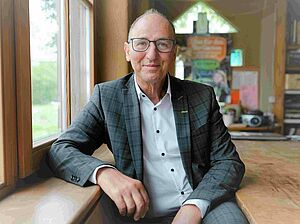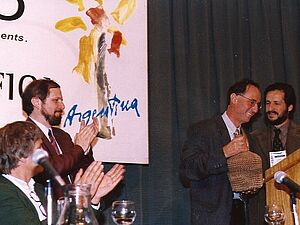"I was in it, body and soul"
50th anniversary voices
IFOAM Conference 1997 in Mar del Plata, Argentina. FiBL was commissioned to organise the IFOAM Conference in 2000. With 1300 organic experts from all over the world, it became the largest conference of the umbrella organisation for organic food and farming to date (from left to right: IFOAM President Hervé La Prairie, IFOAM Director Bernward Geier, Urs Niggli and Guillermo Schnitman, President of the Argentine organic movement MAPO). (Photo: Arturo Encinas)
Urs Niggli was elected FiBL's third director in 1989. He took over the position from his predecessor Henri Suter at the beginning of 1990 and led FiBL Switzerland for 30 years. Since 2020 he has worked for the Institute of Agroecology, for Agroscope and for the foundation Re-Imagine Europa. He is also chairman of FiBL Austria.
If you looked in the direction of Oberwil in the canton of Basel-Landschaft in the mid-1980s, as a young, state-employed agricultural scientist you would feel a slight unusual shudder. The young people who were enthusiastic about organic, were struggling to carry out practical field trials without a laboratory, without machines and with little money. The showpiece was the DOK trial on the nearby farm “Birsmattehof”, run by the Swiss Federal Experimental Station in Liebefeld (now Agroscope), where a FiBL employee was allowed to control the mice. I was fascinated by the potential to achieve something with these people. And I sensed that FiBL could become the start of something big. The "Bio Bud", emblazoned on FiBL's letterhead and its in-house fortnightly magazine "zB", belonged to no one, but became an organising force in a slowly forming alternative agriculture and food sector.
In my dual function as FiBL director and board member of the VSBLO (now Bio Suisse) from 1990 onwards, I quickly understood how the small organic world worked and how it could continue. Later on, Bio Suisse emancipated itself from FiBL, FiBL relinquished its authority to set standards and the Bud logo and focussed on research, advisory services and inspection/certification. The latter part was turned into an independent legal form as "bio.inspecta AG" in 1998. FiBL then very consistently expanded its remaining function as a research and advisory centre for organic agriculture. It was an incredibly exciting, complex and challenging process. During that time, I learned all the skills that I can still muster today. I was in it, body and soul, often using the sofa that stood in my office in the old manufacturer’s mansion on the Bernhardsberg, and was supported by people who trusted me, such as the former Foundation Council President Heinz Zumstein, the first VSBLO President Werner Scheidegger, the experienced organic pioneer, FiBL employee and committed IFOAM specialist Otto Schmid, and Anne Merz, who micromanaged me.
After those first five years, I was constantly chasing new sources of funding. When committed people have goals and ideas, it is almost impossible to catch up with financing them. Every year the budget grew by two to three million. Animal husbandry and animal health, economics and sociology, nutrition and health were added to the classical plant production. Organic agriculture was constantly challenged to increase its expertise in biodiversity, soil protection, climate change and world nutrition. These major issues prompted us to join the EU research programmes in 1993 and to launch projects in Eastern Europe and the Global South in 1996. Our relationship with the Federal Office for Agriculture (FOAG) became increasingly close, by the help of former Federal Councillor Otto Stich, who did a lot for FiBL after his retirement and whose friendly, laconic manner always grounded me.
What remains are thousands of people who worked with us or for us. They are the real legacy of FiBL. I still meet them all over the world and my second life after FiBL became successful because of them. FiBL should strongly cultivate this culture as the creative workshop of the planet's future. It must inspire many people and keep them for short or long moments full of magic. There are few places like this; that is FiBL's unique selling point for the future.





